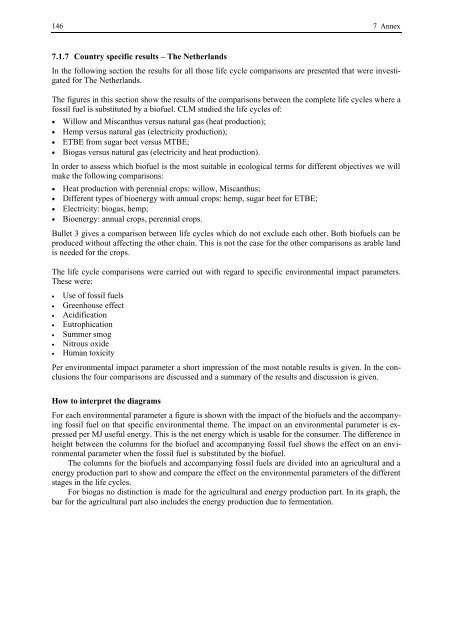BIOENERGY FOR EUROPE: WHICH ONES FIT BEST?
BIOENERGY FOR EUROPE: WHICH ONES FIT BEST?
BIOENERGY FOR EUROPE: WHICH ONES FIT BEST?
You also want an ePaper? Increase the reach of your titles
YUMPU automatically turns print PDFs into web optimized ePapers that Google loves.
146 7 Annex<br />
7.1.7 Country specific results – The Netherlands<br />
In the following section the results for all those life cycle comparisons are presented that were investigated<br />
for The Netherlands.<br />
The figures in this section show the results of the comparisons between the complete life cycles where a<br />
fossil fuel is substituted by a biofuel. CLM studied the life cycles of:<br />
• Willow and Miscanthus versus natural gas (heat production);<br />
• Hemp versus natural gas (electricity production);<br />
• ETBE from sugar beet versus MTBE;<br />
• Biogas versus natural gas (electricity and heat production).<br />
In order to assess which biofuel is the most suitable in ecological terms for different objectives we will<br />
make the following comparisons:<br />
• Heat production with perennial crops: willow, Miscanthus;<br />
• Different types of bioenergy with annual crops: hemp, sugar beet for ETBE;<br />
• Electricity: biogas, hemp;<br />
• Bioenergy: annual crops, perennial crops.<br />
Bullet 3 gives a comparison between life cycles which do not exclude each other. Both biofuels can be<br />
produced without affecting the other chain. This is not the case for the other comparisons as arable land<br />
is needed for the crops.<br />
The life cycle comparisons were carried out with regard to specific environmental impact parameters.<br />
These were:<br />
• Use of fossil fuels<br />
• Greenhouse effect<br />
• Acidification<br />
• Eutrophication<br />
• Summer smog<br />
• Nitrous oxide<br />
• Human toxicity<br />
Per environmental impact parameter a short impression of the most notable results is given. In the conclusions<br />
the four comparisons are discussed and a summary of the results and discussion is given.<br />
How to interpret the diagrams<br />
For each environmental parameter a figure is shown with the impact of the biofuels and the accompanying<br />
fossil fuel on that specific environmental theme. The impact on an environmental parameter is expressed<br />
per MJ useful energy. This is the net energy which is usable for the consumer. The difference in<br />
height between the columns for the biofuel and accompanying fossil fuel shows the effect on an environmental<br />
parameter when the fossil fuel is substituted by the biofuel.<br />
The columns for the biofuels and accompanying fossil fuels are divided into an agricultural and a<br />
energy production part to show and compare the effect on the environmental parameters of the different<br />
stages in the life cycles.<br />
For biogas no distinction is made for the agricultural and energy production part. In its graph, the<br />
bar for the agricultural part also includes the energy production due to fermentation.

















